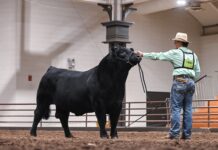During the last couple of weeks in December and into early 2021, eastern Ohio saw warmer-than-usual temperatures and a lot of rain. What does this mean for our pastures and hay fields?
With rain comes the mud, and with mud often comes compaction. Compaction in forage crops often occurs within the top 3-4 inches of soil, but it can also appear at deeper levels, forming “hard pans” that restrict the movement of water.
Compacted soils mean reduced pore space to house water and air — two important components of healthy soils. Nearly half of soils should consist of pore space, whether macro- or micro-pores to allow roots to develop deeper and water to better infiltrate downwards.
Compaction can ultimately lead to increased drought and disease susceptibility of plants, even when it appears there is standing water in a field.
Another key component of healthy soils is the soil biology — microorganisms, earthworms (not the jumping worm kind) and fungi that, among others, help to break down organic materials that improve soil structure and add pore space. When soils are compacted, these biological processes stall, leading to a reduction in organic matter that is broken down.
Identifying
How do you know if your soils are compacted? Short, restricted root systems and standing water can be good indicators. Soil penetrometers can measure the degree of soil compaction when used correctly, but drier soils can lead to higher readings too and do not necessarily mean that soils are compacted. It is recommended that soil penetrometers are used in the spring months when dry soils are less likely to interfere with measurements.
So what are the solutions to compacted soils? I’ve already mentioned a prevention strategy — keep off wet fields. But sometimes this is unavoidable.
Aeration. Research indicates that aeration is only a temporary fix (up to two years) and will not provide long-term benefits. In severe cases, aeration and deep tillage may be able to alleviate some compaction, but research has found in some cases that these practices can make matters even worse.
Grazing height
Controlling grazing height can allow plant roots to grow deeper and prevent compaction issues in the first place. When pasture plants are continuously grazed or hay fields cut too short, this will reflect in the size of the root system. Having a period of rest after grazing can give plants time to recover and allow time for their root systems to grow.
Recognize your soil
Soil characteristics are also important. If you have areas that naturally do not drain well, use grasses such as fescues or reed canary grass that can tolerate those soils. Match the right plant to the right location.
Soil fertility is key for plant growth — soil testing can give you a better idea of what amendments are needed to optimize plant growth and development and ultimately, productivity.
Inevitable
In a lot of cases, mud and compaction will be inevitable. Creating designated winter feed areas (such as a feeding pad) or having a sacrifice paddock can allow other areas to rest enough to recover.
Within sacrificial locations, moving feeders and bunks to different spots can help reduce the amount of mud and manure accumulation in a single area. Furthermore, use plant species that can tolerate heavier traffic in these areas.
Utilizing stockpiled pastures can also alleviate stress on pastures recovering from rain, mud and compaction. Furthermore, this strategy also provides animals with access to higher quality feeds longer into the winter season.
Sometimes, the best thing we can do is nothing — if temperatures start fluctuating to where we begin to get periods of freezing and thawing, it can reduce surface compaction. However, compaction located deeper in the soil, often the result of heavy equipment or frequent traffic, may require attention.
At this point, temperatures for the month of January are forecasted to be hovering between 30-40 degrees Fahrenheit for the highs, leaving some opportunities for even more rain to create mud in our fields.
However, it also looks like the overnight lows dip below freezing, providing opportunities for natural freeze-thaw cycles to correct surface level compaction on its own.
But, remember, giving forages the optimal growing conditions and reducing field traffic will go along way in mitigating compaction and mud issues that develop as we transition from winter into spring.













